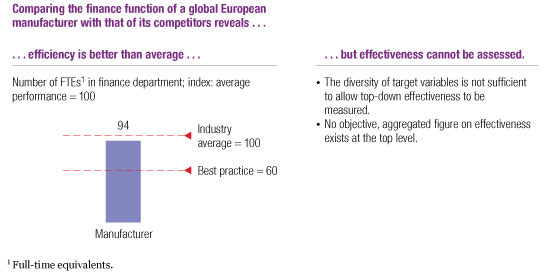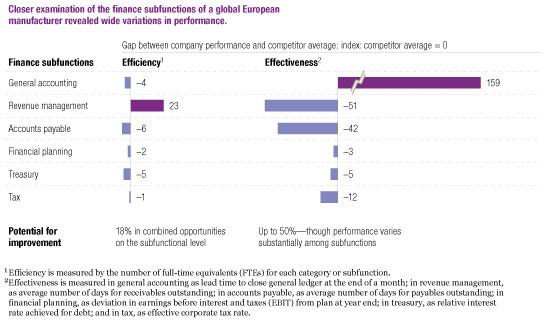Difficult economic times are spurring many CEOs to demand cuts in corporate back offices. And no wonder: finance, HR, IT operations, and other support functions can represent 15 to 20 percent of a global company’s personnel expenses and are thus prime targets for retrenchment. Yet the savings are often fleeting—we find that barely four in ten companies meet their targets one year into a cost-cutting program, and by year four fully 90 percent of back-office costs are right back where they started.
Why? One reason is that many companies pursue sweeping, top-down cuts that—while fast, easy, and seemingly fair—can unintentionally lower the effectiveness of back-office services and thereby fuel resistance among business units, many of which hire back the workers at first opportunity. To understand the risks associated with a broad-brush approach, consider the experience of a global European manufacturer’s finance group, highlighted in the exhibits in this article. This snapshot of one company’s situation is drawn from an ongoing proprietary benchmarking initiative that maps a range of back-office efficiency and effectiveness data at more than 900 companies in Europe and North America.1
A simple head count comparison suggests that the manufacturer’s finance department is somewhat leaner than that of its average competitors, though about a third less lean than that of its most efficient one (Exhibit 1). Many COOs, CFOs, and other executives armed primarily with such high-level information initiate across-the-board layoffs, process improvements, or both. That’s a mistake. In fact, a more granular look at the efficiency of the finance department’s constituent parts (general accounting, treasury, and so on) reveals that only its revenue-management operation has a leaner head count than that of the company’s average competitors. In other words, superior efficiency in one area masks moderate inefficiency throughout the rest (Exhibit 2, left side). Across-the-board layoffs would eliminate muscle as well as fat.
Performing well?

A closer look

Of course, efficiency is only half of the equation. To capitalize on the potential for improvement and make changes stick, executives must also consider the effectiveness of back-office services. Here too a closer look is revealing, as it suggests that the manufacturer’s revenue-management operation, which takes fully twice as long as its rivals do to secure payment, is far less effective than its peers in managing receivables. Applying this lens to the rest of the company’s finance group suggests that its services could be 50 percent more effective (Exhibit 2, right side). The manufacturer’s executives could use that information to begin developing more accurate—and realistic—targets for efficiency and effectiveness. Simultaneously, they could probe the root causes of these performance deficits to learn where lean and other process-improvement techniques might be advantageous.
Companies miss such opportunities when they take a hands-off approach to managing back-office complexity. By contrast, top companies closely monitor both the efficiency and the effectiveness of support activities and recognize that improvements to the former need not come at the expense of the latter (a key insight confirmed by our research). In fact, there are often interdependencies between the two. Greater effectiveness can even contribute to higher efficiency. Within the finance function, for example, paying more attention to the creditworthiness of customers and setting shorter payment cycles (effectiveness gains) help reduce the need for write-offs and make posting to accounts more straightforward (greater efficiency).
Mastering such interdependencies across the breadth of a company’s back-office operations pays big dividends. If an average performer in our database raised its back-office efficiency and effectiveness to top-quartile levels, it would improve its net margin by two percentage points. Moreover, greater transparency allows companies to make better offshoring decisions and to integrate back-office services more closely with core businesses, improving productivity in adjacent areas—all while helping to ensure that operational improvements stick.
